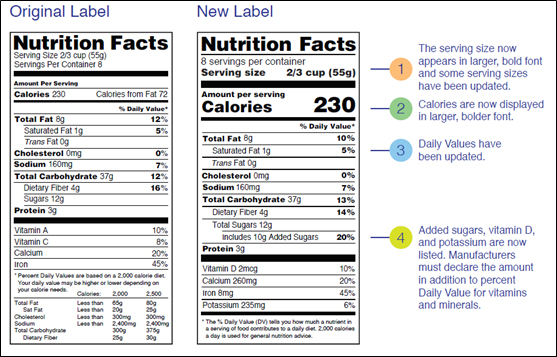
One of the most recent amendments applied in the year 2020 for the labeling compliance of food and drinks is the update of the Nutritional Facts Panel by the United States Food and Drug Administration. It is solely based on scientific information, new nutrition research, and various other inputs from the public. The amendment has been made by taking certain factors into consideration, most important of which was the ease for a consumer to choose better food and make informed food choices leading to a long and healthy life.
How are these aspects different from the previous labels? Let’s have a look at what exactly needs to be updated.
1. Enlargement of the Serving Size:
The information related to servings, i.e., servings per container and the serving size information will have to be printed in large and in bold format from now onwards. Since, the FDA clearly states that serving size is not a recommendation of how much to eat, although, this change was inspired on having a better understanding of the consumer’s eating and drinking patterns.
2. Enlargement of the Calories Font:
For customers to find the number of calories in a much easier way, the FDA now mandates to use larger and bold font while mentioning calories on food and drinks. Calorie requirement varies with respect to sex, age, height, weight, and physical activity level. While one should be aware of the number of calories that are to be consumed in a day, the FDA wants the consumers of America to be aware of the calories they are consuming in the packaged food.
3. Prominent Description of High and Low Percentage of Daily Value:
As per the FDA, the percent Daily Value (%DV) shows how much a nutrient in a serving of food contributes to a total daily diet. A new guidance has been provided which defines what constitutes lower and higher daily values. These are:
- 5% DV or less of a nutrient per serving is considered low
- 20% DV or more of a nutrient per serving is considered high
Also, the footnote at the bottom of the label has also been updated to better explain %DV.
4. Updated Nutrients List:
FDA has made significant additions and deletions in this section.
To talk about deletion, two (2) things have been removed from the nutrients list:
- Calories from fat have been removed as research shows the type of fat consumed is more important than the amount.
- Vitamin A and C are no longer a mandate on the label since deficiencies of these vitamins are rare in today’s world. Hence, these nutrients can be included on a voluntary basis but are not compulsory to be updated on the label as per the guidelines of the FDA.
Additions to the nutritional facts panel include:
- Added sugars have been added to the label because consuming high quantity of added sugars can make it hard to meet nutrient needs while staying within calorie limits. Added sugars include sugars that are added during the processing of foods (such as sucrose or dextrose), foods packaged as sweeteners (such as table sugar), sugars from syrups and honey, and sugars from concentrated fruit or vegetable juices.
- Vitamin D and potassium are now required to be listed on the label because Americans do not always get the recommended amounts. Diets higher in vitamin D and potassium can reduce the risk of osteoporosis and high blood pressure, respectively.
Below provided is the pictorial summary of what constitutes the new amendment as per the FDA.

Reference: https://www.fda.gov/media/135197/download
It has happened for the very first time in a span of 20 years that the FDA has updated the nutrition facts label for all packaged food products. While existing manufacturers have time until July 2021 to comply with the updated regulations, the new manufacturers and distributors are already taking care of the label compliance in this regard. As per the FDA, manufacturers with $10 million or more in annual sales were required to update their labels by January 1, 2020; manufacturers with less than $10 million in annual food sales were required to update their labels by January 1, 2021. Have you made up your food product’s label aligning with the amendment? Evaluate now. Consult an expert.









